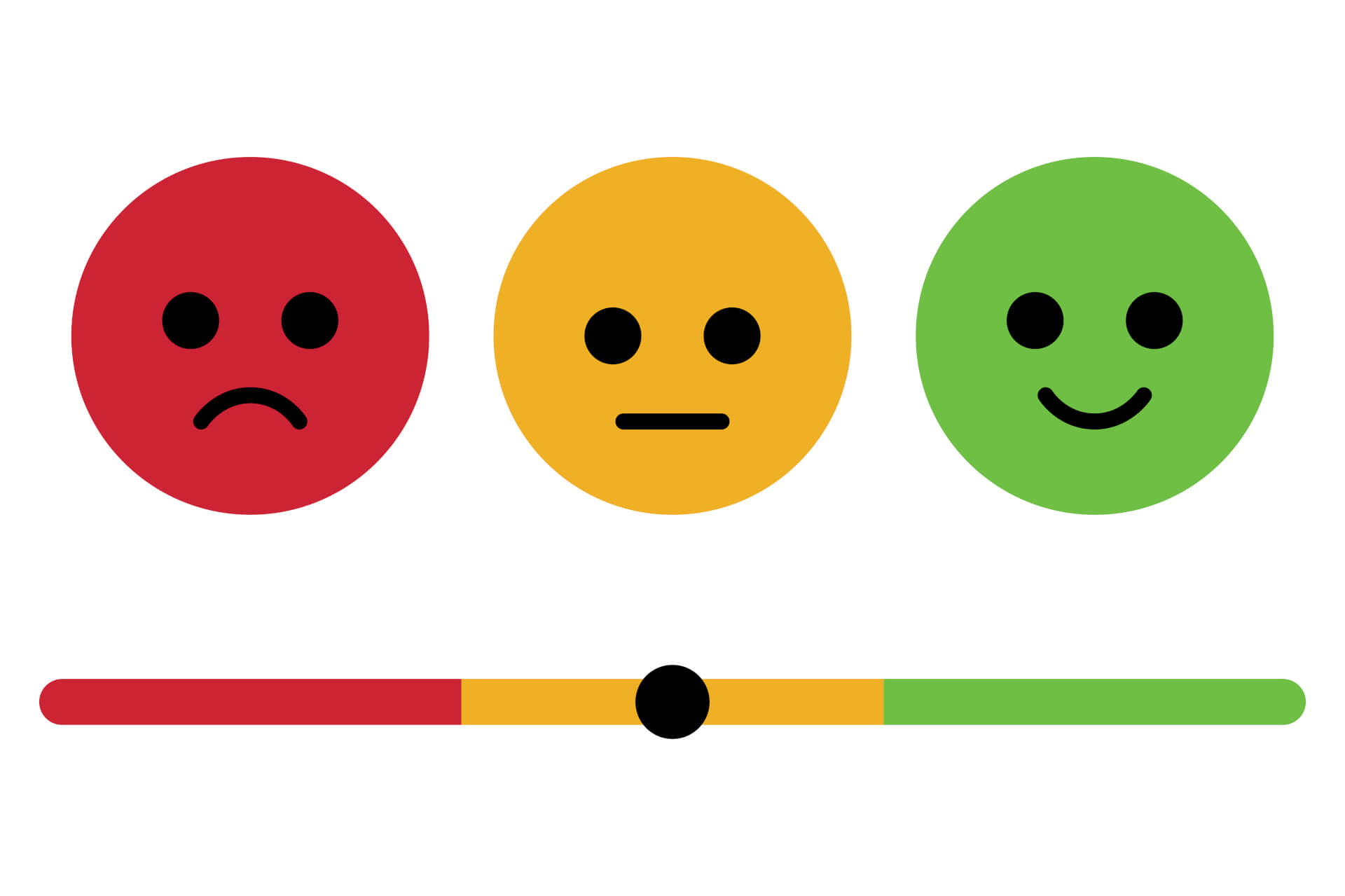Using a Net Promoter Score survey allows companies to learn more about customers. Evaluating and segmenting the feedback received enables a close look at customer behavior, gives an insight into needs and wishes and makes it clear which measures must be proactively taken to improve service, customer satisfaction and thus increase sales.
But how is this calculation carried out, how can customer satisfaction be measured?
The NPS formula - a simple basis.
To calculate the Net Promoter Score, customers are asked on a scale from 0 to 10 how likely they are to recommend your company to friends and acquaintances.
For a segmentation of the customers, they are divided into the following groups based on the rating:
- Critics:
With a rating between 0-6 points - Passives:
With a rating between 7-8 points - Promoters:
With a rating between 9-10 points
After the survey, subtract the percentage of all detractors from the percentage of all promoters to get a value. This value is called the Net Promoter Score.
 Recommended reading: If you would like to learn more about satisfaction metrics, we recommend our article "NPS vs. Customer Satisfaction Scores - A Quick Overview"
Recommended reading: If you would like to learn more about satisfaction metrics, we recommend our article "NPS vs. Customer Satisfaction Scores - A Quick Overview"
The NPS formula – the mathematical calculation.
Let's look at the formula - basic again.
Net Promoter Score = (Number of Promoter Scores/Total Respondents) – (Number of Detractor Scores/Total Respondents)
For example, if you survey 100 customers and the responses consist of 70 promoters, 10 passives, and 20 detractors:
Net Promoter Score = (70% - 20% ) = 50.
Link tip: The calculation is very easy with our online NPS calculator.
Implementation of the NPS
In order to obtain data for the calculation of the NPS, the customers have to be surveyed. With the following steps you can integrate the Net Promoter Score into your processes.
Survey your customers
"On a scale from 0 to 10, how likely is it that you would recommend our company to a friend or acquaintance?"
This NPS key question can be used in a number of ways: in the form of a survey, after a customer interaction, in the form of a pop-up notification on the website, or as a social media poll.
In order to measure the NPS accurately, the formulation of the core question is important, as is the possibility to give a rating between 0 and 10 points.
Add a free text field at the end of the survey so customers can explain why they left their review. This also enables you to collect more feedback and thus valuable information on necessary improvements.
Categorize the answers
Once you have received survey responses, begin sorting them into Promoters, Passives, and Detractors based on their score.
Each group has to be treated differently later.
- Promoters are your satisfied customers who recommend your company.
- Passives are customers for whom your offer is sufficient, but not yet enthusiastic. These customers are more likely to churn if they find a cheaper deal.
- Critics are dissatisfied and will not only leave, but with the negative feedback they will discourage potential new customers from trying out your offer.
Create a strategy for each group to increase satisfaction and improve customer lifetime.
Calculate the NPS value
- Count the total number of responses and calculate the NPS value as previously described by dividing the number of people who gave you a positive rating by the total number of respondents.
- Then repeat these steps for people who rated you negatively.
- Then subtract the detractor percentage from the promoter percentage to get your NPS score.
This completes the basic NPV value calculation.
How do you use the collected feedback to evaluate not only quantitative feedback but also qualitative feedback and to further improve your service for your customers? To do this, you should ask yourself the following questions.

Reading recommendation: Would you like to know more about integrating the Net Promoter Score? Then we recommend our blog article “How to implement NPS in your company”
Are your customers satisfied or are they at risk of leaving?
Basically, your customer NPS shows how satisfied your customers are. The better the NPS value, the more promoter you are compared to critics.
Simply put, it shows how satisfied your customers are. If you consider the fact that a promoter has a 600% to 1400% higher customer lifetime value than a critic, the NPS value also shows how successfully you work.
Customer NPS allows you to assess your customers' perception of your business and take appropriate action based on how high - or low - the NPS score is.
 Reading recommendation: You can find out what you should consider when implementing it in practice in our blog article “How to effectively implement an NPS data analysis”
Reading recommendation: You can find out what you should consider when implementing it in practice in our blog article “How to effectively implement an NPS data analysis”
How do your customers' opinions evolve over time?
Be careful not to just take a snapshot. Measure NPS over time to see how perception and satisfaction have evolved.
If the NPS increases, that's good news. Your actions are showing results. If the NPS goes down, you need to do a thorough investigation. The measures do not work here, they may have been placed incorrectly or, in the event of an increase in passives, are of no interest to your customers.
If so, dig deeper into your customers' qualitative feedback to get more information.
Qualitative feedback is very important because it provides you with direct pointers to necessary improvements and enables you to turn a critic into a confident promoter simply by implementing this criticism.
You can also work with keywords to identify these problems even more quickly.
 Recommended reading: Customer sentiment can be very volatile. Collecting NPS manually is very time-consuming. In our blog article we will show you the “Benefits of Outsourcing Your NPS Process”
Recommended reading: Customer sentiment can be very volatile. Collecting NPS manually is very time-consuming. In our blog article we will show you the “Benefits of Outsourcing Your NPS Process”
What changes do you need to make?
If you have received feedback with wishes and suggestions for improvement, it is important to work directly on the implementation.
You probably can't make these changes overnight, but with the qualitative NPS feedback you get can spark a conversation about new products and services, giving you more detail about what the customer wants and wants. Just making the customer heard and showing that you care about their feedback can be enough to convince the critic of your company.
In this way, you gain more promoters, which in turn give you more new customers and lower your costs through referral marketing.
This is important, growing businesses prioritize customer success and use NPS to focus on increasing customer retention rates.
Why? Well, a 5% increase in customer retention actually increases profits by 25% to 95%.

Recommended reading: But how long is feedback qualitative? Our blog article asks the question: "When is an NPS response considered expired and can therefore be discarded?"
Where and when do I use the surveys?
The timing of the survey is very important. Be sure to place the surveys in the right place.
For this you need to know 2 forms of the NPS survey:
Relationship NPS - based on the relationship with the customer
In order to build a long-term and healthy customer relationship, it is important that you periodically survey your existing customers to ensure that they are satisfied.
An example of using an NPS survey based on the relationship with your customer is to survey existing customers quarterly or semi-annually and segment the promoters to ask these convinced customers for a customer review or rating on an external portal.
The question about the review is addressed to all customers who have given a rating of 9 or 10 points as part of the thank you page. This is a great way to build stronger relationships with your loyal customers.
Transactional NPS - based on the event
You implement transactional NPS surveys at important points in the customer life cycle.
For example after a purchase or after a completed support request. Transactional NPS surveys can also be carried out for customers who have not logged in for a certain period of time.
Look closely at each point in the customer journey to decide where to successfully apply NPS.

Reading recommendation: Further information on the areas of application of an NPS survey can be found in our article "Basic areas of application for your NPS satisfaction analysis"
Technological Advancements in NPS Surveys
Automation Tools
Automation tools streamline the process of sending and analyzing NPS surveys. They ensure timely distribution, follow-ups, and data collection, reducing manual effort.
Integration with CRM Systems
Integrating NPS surveys with CRM systems allows businesses to link feedback with customer data. This integration provides a holistic view of customer interactions and helps personalize follow-up actions.
AI and Machine Learning in Survey Analysis
AI and machine learning enhance the analysis of NPS data by identifying patterns and trends. These technologies can predict customer behavior, segment responses, and provide deeper insights.
Real-time NPS Tracking
Real-time NPS tracking allows businesses to monitor customer sentiment continuously. This immediacy enables quick responses to emerging issues and enhances overall customer experience management.
 Reading Tipp: In our Blog Article "The Future of the NPS", we will explore seven predictions on the future of the NPS.
Reading Tipp: In our Blog Article "The Future of the NPS", we will explore seven predictions on the future of the NPS.
Save time and effort with Callexa
As you can see, the survey with NPS is a simple survey that customers like to answer. The calculation of the NPS is also kept simple.
Applying these steps, especially the necessary measures after the survey, all in a structured manner and evaluating them later can become a time-consuming and strenuous task.
Callexa offers you a ready-made tool that you can adapt to the specific needs of your company and implement in your routines within minutes.
Save time and effort and start surveying your customers today. With our Callexa "Free" tariff, you can already survey 50 recipients per month free of charge and see for yourself the added value that an NPS survey brings.